A PMU-Based Method for Smart Transmission Grid Voltage Security Visualization and Monitoring
Abstract
:1. Introduction
2. Review of the Impedance Match Method to Static Voltage Stability Analysis
3. Proposed Method
3.1. Determination of Load Increase Direction
3.2. Estimation of Thevenin Equivalent Network Parameters
3.3. Estimation of Loading Margin
3.4. Construction of Voltage Stability Boundary
| Algorithm 1. Construction of a VSB curve in P-Q plane. |
| 1: Input: and ; 2: for do 3: for do 4: ; 5: ; 6: ImpedanceMargin(); 7: PowerMargin(); 8: ; 9: ; 10: ; 11: end for 12: 13: end for 14: Determine by Equation (24); 15: Construct a VSB curve by Equation (23); 16: return VSB curve 17: function ImpedanceMargin() 18: Compute by Equation (7); 19: Compute by Equation (8); 20: ; 21: return 22: end function 23: function PowerMargin() 24: Compute by Equation (22); 25: Compute by Equation (21); 26: return 27: end function |
4. Case Studies
4.1. Load Change Cases
4.1.1. IEEE 14-Bus Model
4.1.2. IEEE 30-Bus Model
4.1.3. Statistical Evaluation
4.2. Topology Change Cases
4.3. Visualization of VSB in P-Q Plane
4.4. Effects of Measurement Inaccuracies
5. Conclusions
Acknowledgments
Author Contributions
Conflicts of Interest
References
- Andersson, G.; Donalek, P.; Farmer, R.; Hatziargyriou, N.; Kamwa, I.; Kundur, P.; Martins, N.; Paserba, J.; Pourbeik, P.; Sanchez-Gasca, J.; et al. Causes of the 2003 major grid blackouts in north America and Europe, and recommended means to improve system dynamic performance. IEEE Trans. Power Syst. 2005, 20, 1922–1928. [Google Scholar] [CrossRef]
- Simpson-Porco, J.W.; Dörfler, F.; Bullo, F. Voltage collapse in complex power grids. Nat. Commun. 2016. [Google Scholar] [CrossRef] [PubMed]
- Ajjarapu, V. Computational Techniques for Voltage Stability Assessment and Control; Springer-Verlag: New York, NY, USA, 2006. [Google Scholar]
- Su, H.-Y.; Hsu, Y.-L.; Chen, Y.-C. PSO-Based Voltage Control Strategy for Loadability Enhancement in Smart Power Grids. Appl. Sci. 2016, 6, 449. [Google Scholar] [CrossRef]
- Deng, W.; Zhang, B.; Ding, H.; Li, H. Risk-Based Probabilistic Voltage Stability Assessment in Uncertain Power System. Energies 2017, 10, 180. [Google Scholar] [CrossRef]
- Flatabo, N.; Ognedal, R.; Carlsen, T. Voltage stability condition in a power transmission system calculated by sensitivity methods. IEEE Trans. Power Syst. 1990, 5, 1286–1293. [Google Scholar] [CrossRef]
- Flatabo, N.; Fosso, O.; Ognedal, R.; Carlsen, T. A method for calculation of margins to voltage instability applied on the Norwegian system for maintaining required security level. IEEE Trans. Power Syst. 1993, 8, 920–928. [Google Scholar] [CrossRef]
- Ajjarapu, V.; Christy, C. The continuation power flow: A tool for steady state voltage stability analysis. IEEE Trans. Power Syst. 1992, 7, 416–423. [Google Scholar] [CrossRef]
- Chiang, H.D.; Flueck, A.J.; Shah, K.S.; Balu, N. CPFLOW: A practical tool for tracing power system steady-state stationary behavior due to load and generation variations. IEEE Trans. Power Syst. 1995, 10, 623–634. [Google Scholar] [CrossRef]
- Vu, K.; Begovic, M.M.; Novosel, D.; Saha, M.M. Use of local measurements to estimate voltage-stability margin. IEEE Trans. Power Syst. 1999, 14, 1029–1035. [Google Scholar] [CrossRef]
- Smon, I.; Verbic, G.; Gubina, F. Local voltage-stability index using Tllegen’s theorem. IEEE Trans. Power Syst. 2006, 21, 1267–1275. [Google Scholar] [CrossRef]
- Corsi, S.; Taranto, G.N. A real-time voltage instability identification algorithm based on local phasor measurements. IEEE Trans. Power Syst. 2008, 23, 1271–1279. [Google Scholar] [CrossRef]
- Verbic, G.; Gubina, F. A new concept of voltage-collapse protection based on local phasors. IEEE Trans. Power Del. 2004, 19, 576–581. [Google Scholar] [CrossRef]
- Parniani, M.; Vanouni, M. A fast local index for online estimation of closeness to loadability limit. IEEE Trans. Power Syst. 2010, 25, 584–585. [Google Scholar] [CrossRef]
- Sun, T.; Li, Z.; Rong, S.; Lu, J.; Li, W. Effect of Load Change on the Thevenin Equivalent Impedance of Power System. Energies 2017, 10, 330. [Google Scholar] [CrossRef]
- Phadke, A.G.; Thorp, J.S. Synchronized Phasor Measurements and Their Applications; Springer-Verlag: New York, NY, USA, 2008. [Google Scholar]
- Aminifar, F.; Fotuhi-Firuzabad, M.; Safdarian, A.; Davoudi, A.; Shahidehpour, M. Synchrophasor measurement technology in power systems: Panorama and state-of-the-art. IEEE Access 2014, 2, 1607–1628. [Google Scholar] [CrossRef]
- Martin, K.E. Synchrophasor standards development-IEEE C37.118 & IEC 61850. In Proceedings of the 44th Hawaii International Conference on System Sciences, Kauai, HI, USA, 4–7 January 2011; pp. 1–8. [Google Scholar]
- Dubrovin, B.A.; Fomenko, A.T.; Novikov, S.P. Modern Geometry-Methods and Applications; Springer-Verlag: New York, NY, USA, 1984. [Google Scholar]
- Taylor, C.W. Power System Voltage Stability; McGraw-Hill: New York, NY, USA, 1994. [Google Scholar]
- Van Cutsem, T.; Vournas, C. Voltage Stability of Electric Power Systems; Kluwer: Norwell, MA, USA, 1998. [Google Scholar]
- Power Systems Test Case Archive, University of Washington College of Engineering. Available online: http://www.ee.washington.edu/re-serach/pstcal/ (accessed on 14 April 2017).
- Tate, J.E.; Van, Cutsem T. Extracting steady state values from phasor measurement unit data using FIR and median filters. In Proceedings of the 2009 IEEE/PES Power Systems Conference and Exposition, Seattle, WA, USA, 15–18 March 2009; pp. 1–6. [Google Scholar]
- Glavic, M.; Van Cutsem, T. Wide-area detection of voltage instability from synchronized phasor measurements, part I: Principle. IEEE Trans. Power Syst. 2009, 24, 1408–1416. [Google Scholar] [CrossRef]
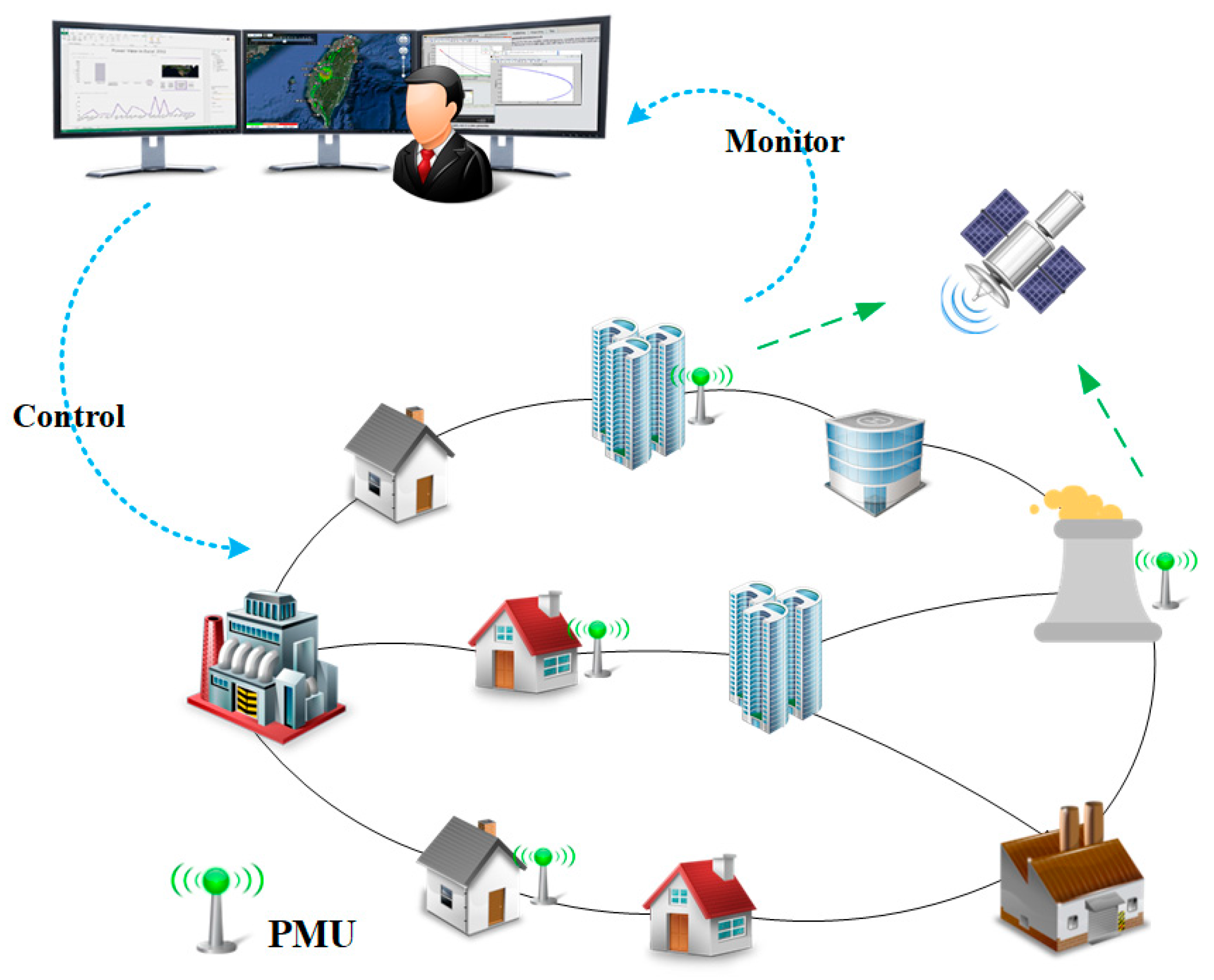
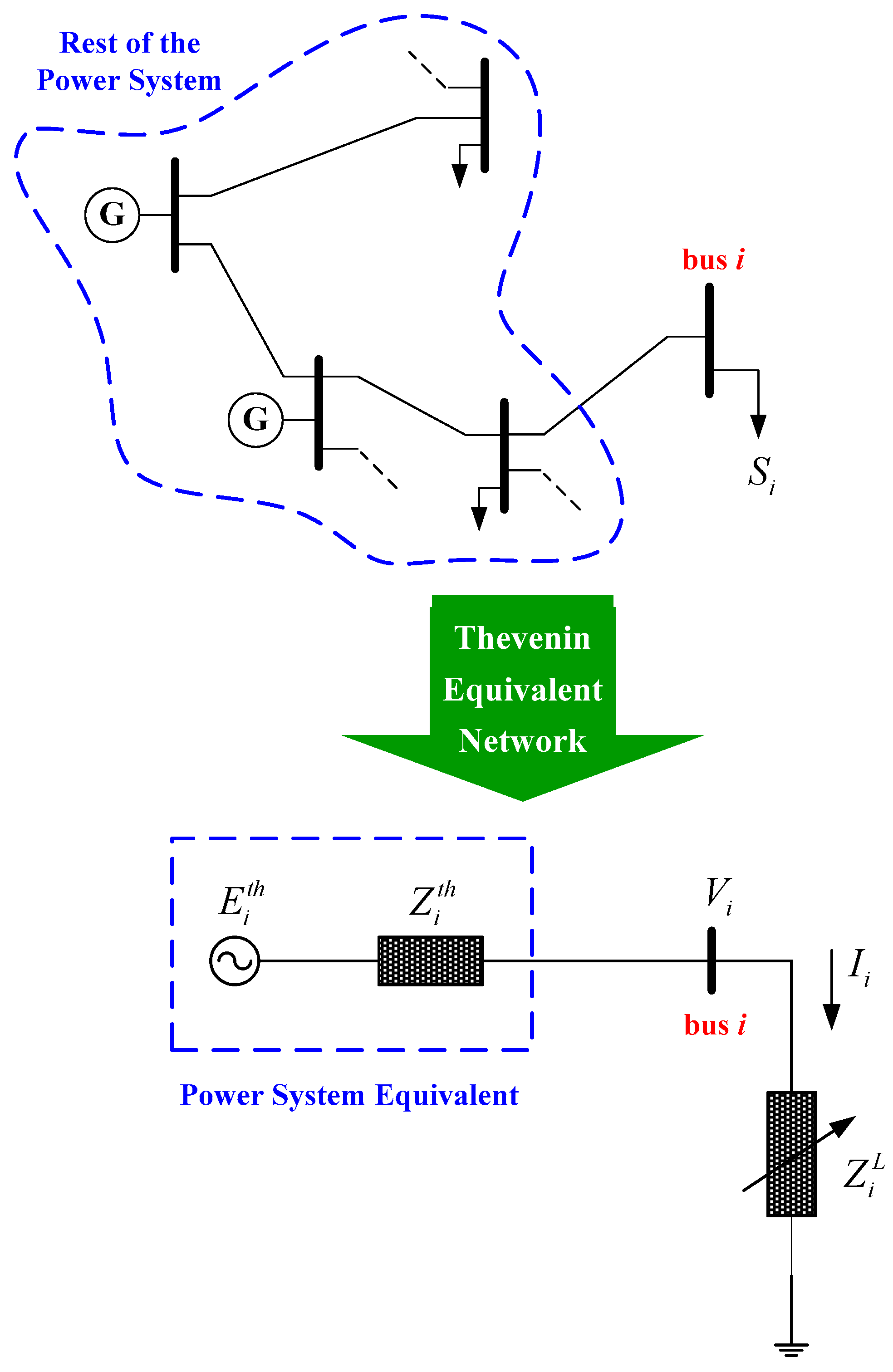
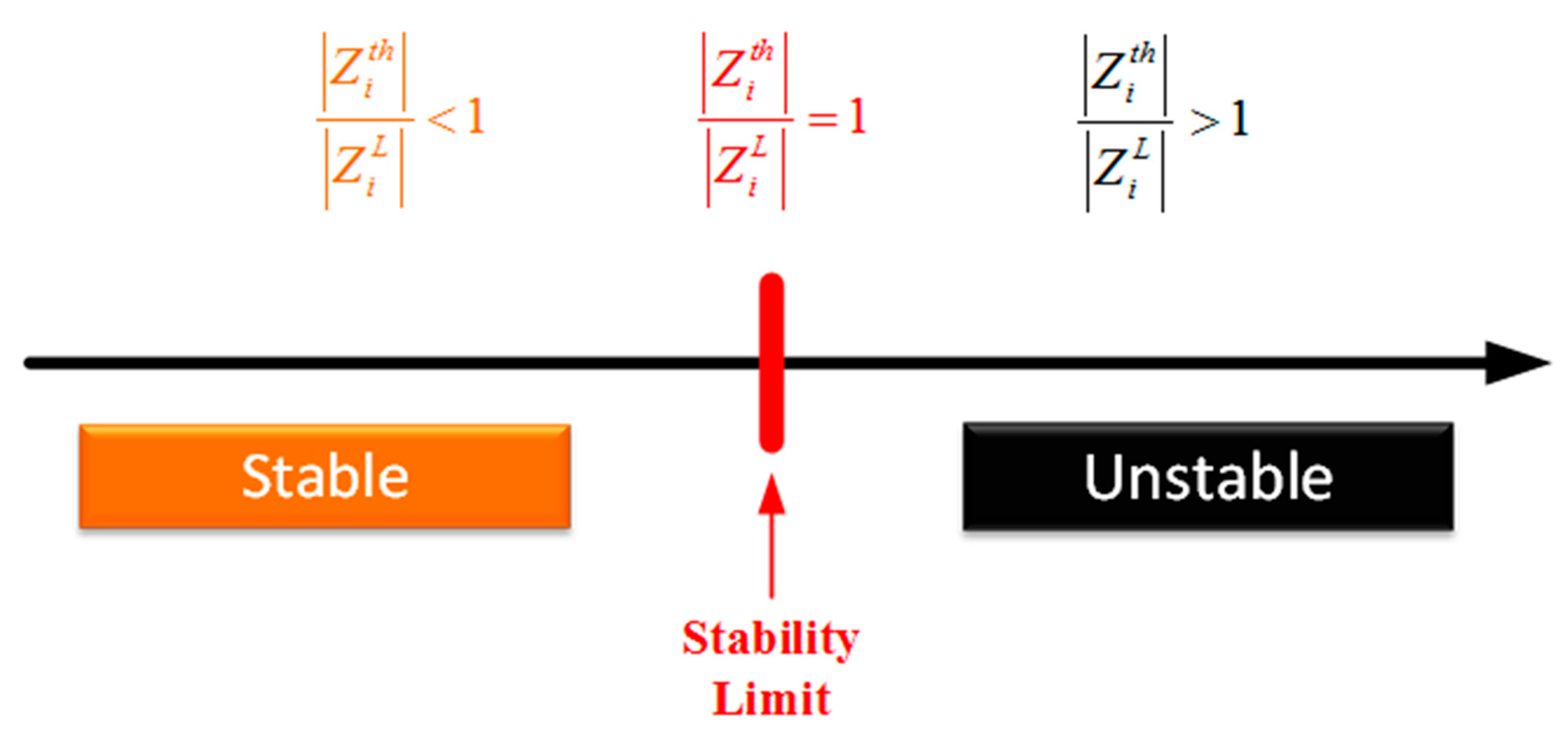

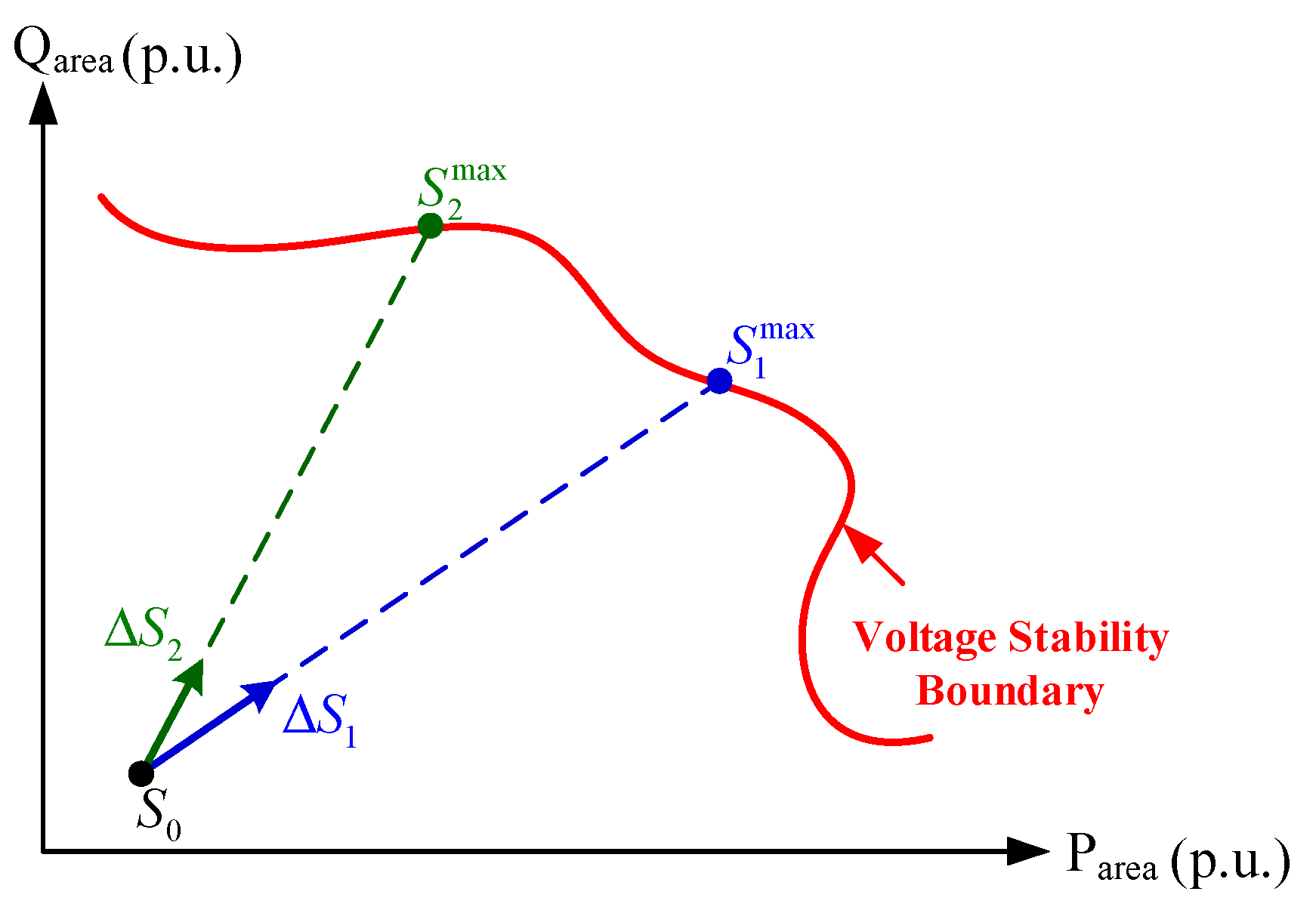
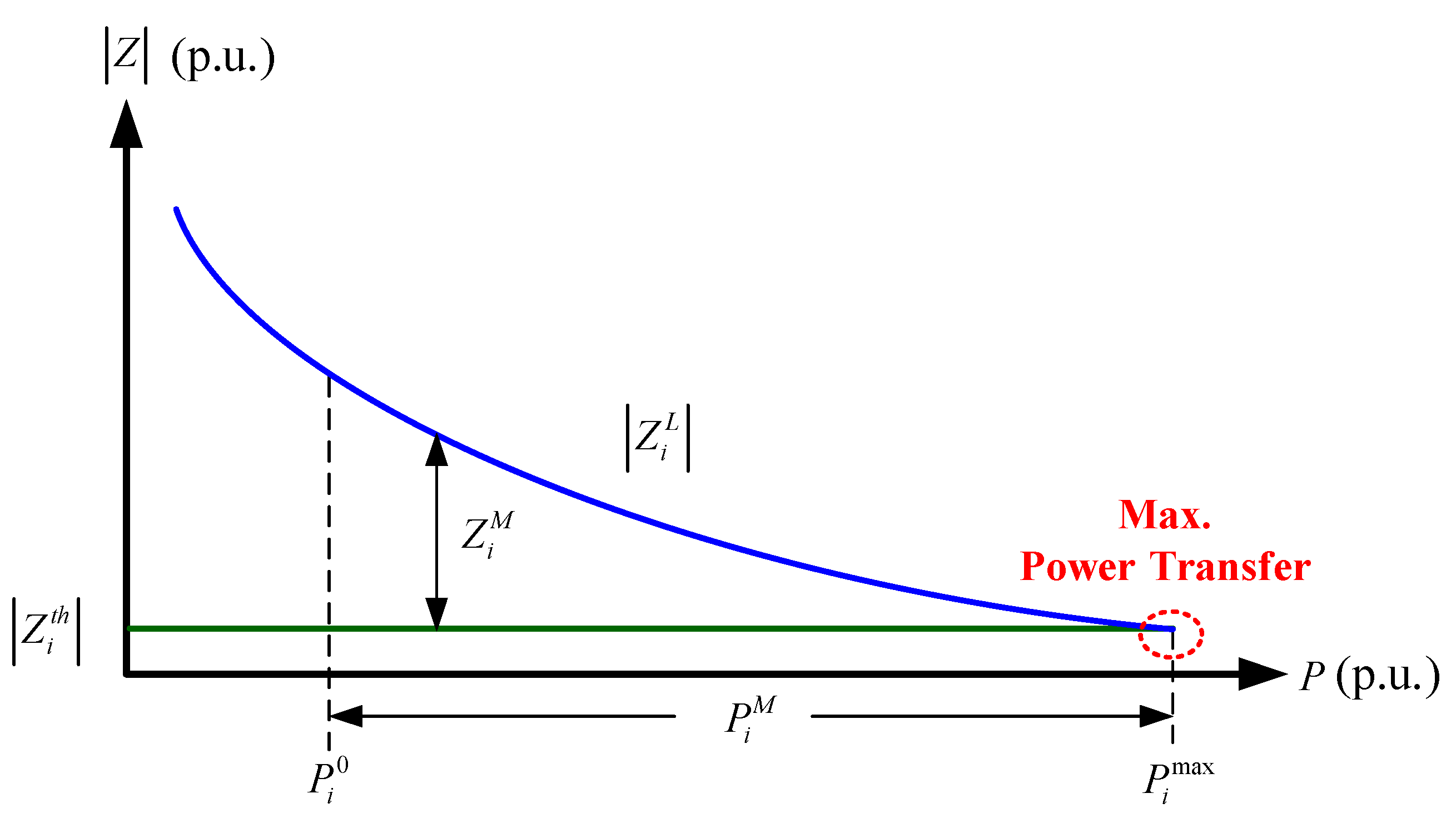


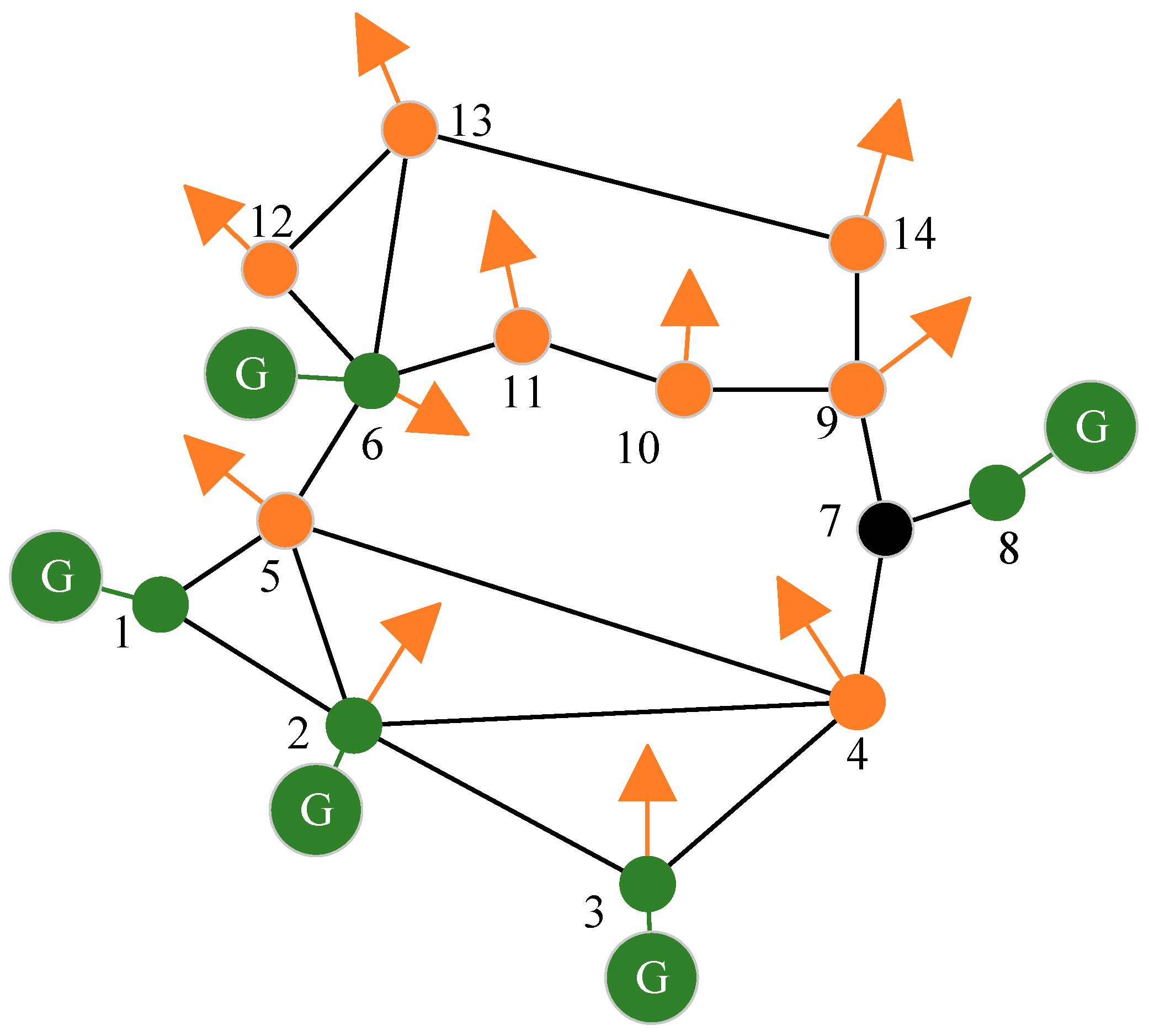
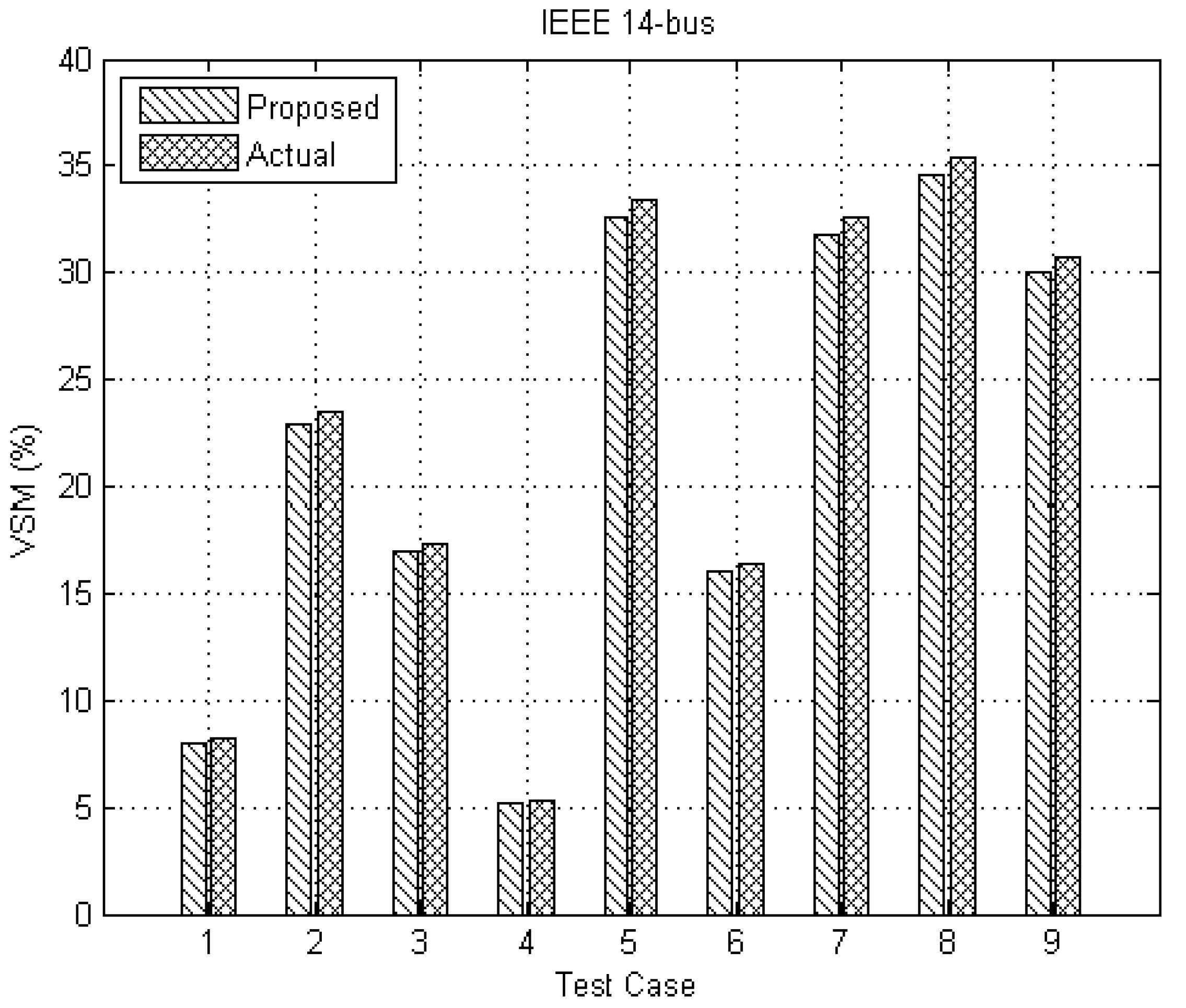
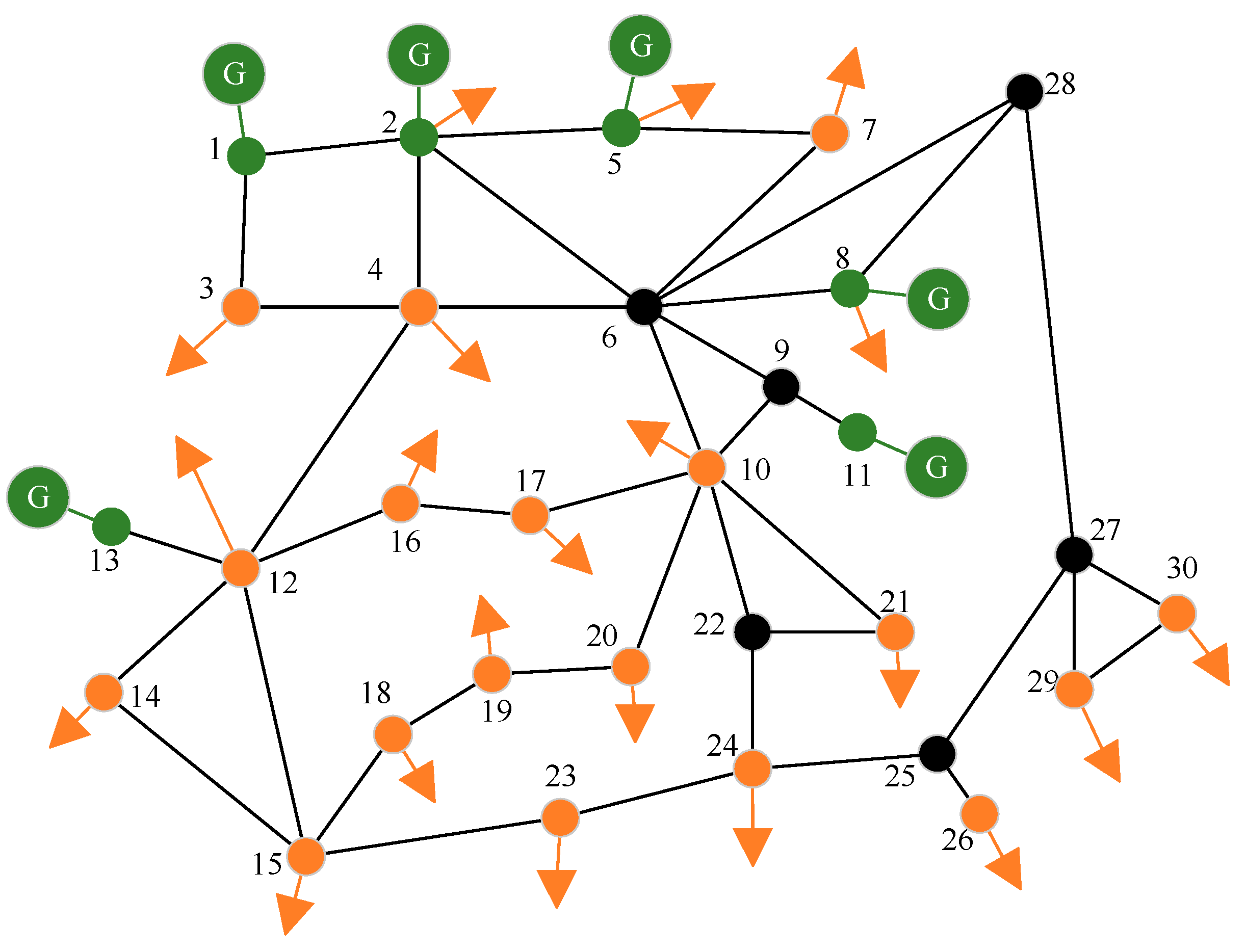

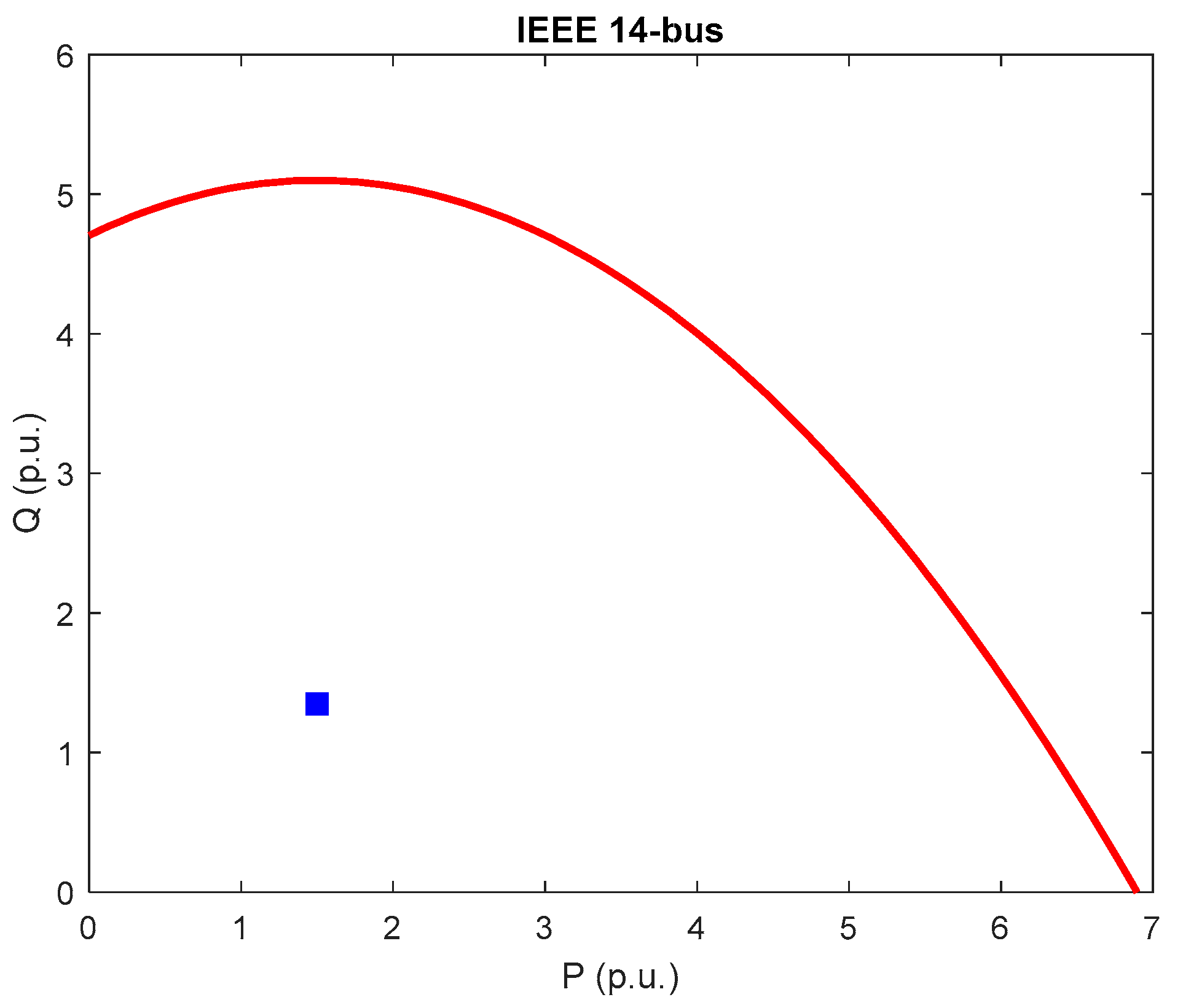
| Number of | IEEE 14-Bus | IEEE 30-Bus | IEEE 57-Bus | IEEE 118-Bus | IEEE 300-Bus |
|---|---|---|---|---|---|
| Generators | 5 | 6 | 7 | 54 | 69 |
| Loads | 9 | 24 | 50 | 64 | 231 |
| Lines | 20 | 41 | 80 | 186 | 411 |
| Scenario | Description | ||||
| Load change | Various load levels together with various load patterns | ||||
| Topology change | Transmission line and generator outages | ||||
| Case | Load Level | Load Pattern |
|---|---|---|
| 1 | ||
| 2 | ||
| 3 | ||
| 4 | ||
| 5 | ||
| 6 | ||
| 7 | ||
| 8 | ||
| 9 |
| Test System | VSM (%) | Time (s) | EC | |||
|---|---|---|---|---|---|---|
| Proposed | CPF | Proposed | CPF | Proposed | CPF | |
| IEEE 14-bus | 22.17 | 22.48 | 0.25 | 1.36 | 5.38 | 0.99 |
| IEEE 30-bus | 34.01 | 34.63 | 0.41 | 2.59 | 3.74 | 0.59 |
| IEEE 57-bus | 17.57 | 17.96 | 1.06 | 6.04 | 1.17 | 0.21 |
| IEEE 118-bus | 9.06 | 9.41 | 1.62 | 10.34 | 0.59 | 0.09 |
| IEEE 300-bus | 12.94 | 13.27 | 12.44 | 73.42 | 0.09 | 0.02 |
| Test System | Out of Service | EC | |
|---|---|---|---|
| Proposed | CPF | ||
| IEEE 14-bus | Line 9–10 | 5.25 | 1.36 |
| Line 12–13 | 4.94 | 0.98 | |
| G2 | 5.03 | 1.01 | |
| IEEE 30-bus | Line 21–22 | 3.68 | 0.63 |
| Line 10–17 | 3.31 | 0.47 | |
| G13 | 3.97 | 0.72 | |
| IEEE 57-bus | Line 23–24 | 1.78 | 0.59 |
| Line 9–55 | 1.04 | 0.15 | |
| G8 | 1.36 | 0.34 | |
| IEEE 118-bus | Line 18–19 | 0.63 | 0.19 |
| Line 63–64 | 0.58 | 0.11 | |
| G24 | 0.60 | 0.14 | |
| IEEE 300-bus | Line 11–13 | 0.14 | 0.05 |
| Line 15–37 | 0.08 | 0.02 | |
| G10 | 0.11 | 0.04 | |
| Test System | ||
|---|---|---|
| Proposed | CPF | |
| IEEE 14-bus | 5.07 | 1.12 |
| IEEE 30-bus | 3.65 | 0.64 |
| IEEE 57-bus | 1.39 | 0.37 |
| IEEE 118-bus | 0.61 | 0.15 |
| IEEE 300-bus | 0.12 | 0.04 |
| Test System | Error (%) | |
|---|---|---|
| No Measurement Errors | With Measurement Errors | |
| IEEE 14-bus | −1.56 | −4.66 |
| IEEE 30-bus | −2.05 | −5.24 |
| IEEE 57-bus | −1.79 | −4.98 |
| IEEE 118-bus | −2.46 | −5.47 |
| IEEE 300-bus | −2.34 | −5.31 |
© 2017 by the authors. Licensee MDPI, Basel, Switzerland. This article is an open access article distributed under the terms and conditions of the Creative Commons Attribution (CC BY) license (http://creativecommons.org/licenses/by/4.0/).
Share and Cite
Su, H.-Y.; Liu, T.-Y. A PMU-Based Method for Smart Transmission Grid Voltage Security Visualization and Monitoring. Energies 2017, 10, 1103. https://doi.org/10.3390/en10081103
Su H-Y, Liu T-Y. A PMU-Based Method for Smart Transmission Grid Voltage Security Visualization and Monitoring. Energies. 2017; 10(8):1103. https://doi.org/10.3390/en10081103
Chicago/Turabian StyleSu, Heng-Yi, and Tzu-Yi Liu. 2017. "A PMU-Based Method for Smart Transmission Grid Voltage Security Visualization and Monitoring" Energies 10, no. 8: 1103. https://doi.org/10.3390/en10081103




